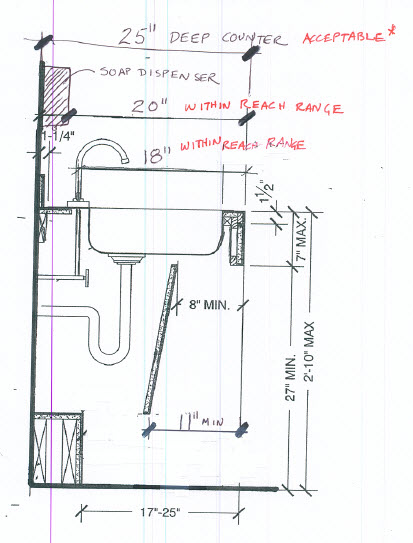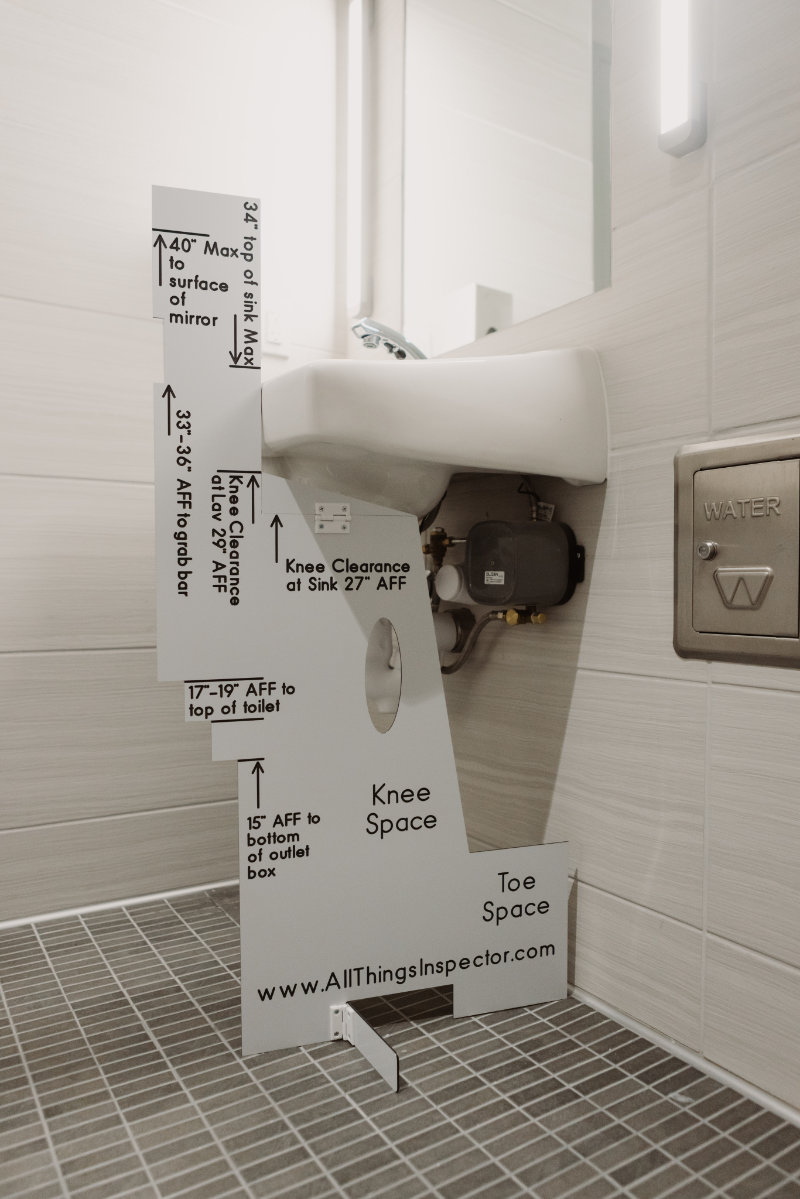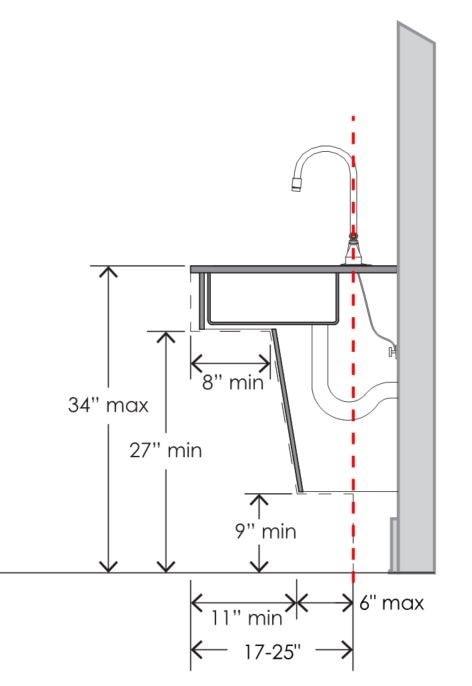The Americans with Disabilities Act (ADA) sets standards for accessibility in public spaces, including requirements for kitchen sinks. These specifications ensure that individuals with disabilities can use kitchen sinks comfortably and safely. As a homeowner or contractor, it is important to be aware of these ADA compliance specs to ensure your kitchen sink is accessible to all. ADA Compliance for Kitchen Sinks
The ADA has specific requirements for kitchen sinks to ensure they are usable by individuals with disabilities. These requirements include sink height, depth, clearance, and faucet design. These specs are important to follow to ensure an accessible and functional kitchen sink for all users. ADA Kitchen Sink Requirements
The ADA requires kitchen sinks to have a maximum rim height of 34 inches and a minimum rim height of 29 inches. This allows individuals using wheelchairs to comfortably reach the sink and use it without obstruction. The height of the sink can be adjusted by using a raised base or installing a sink with an adjustable height feature. ADA Kitchen Sink Height
The depth of the sink is also an important factor in ADA compliance. The ADA requires a maximum sink depth of 6.5 inches to ensure that individuals using wheelchairs or with limited mobility can easily reach the bottom of the sink. A shallow sink depth also makes it easier for individuals to wash dishes and perform other tasks without strain. ADA Kitchen Sink Depth
Clearance space around the kitchen sink is crucial for ADA compliance. The ADA requires a clear floor space of at least 30 inches by 48 inches in front of the sink. This allows for wheelchair users to maneuver and park their chair comfortably in front of the sink. Additionally, the ADA requires a clearance space of at least 27 inches under the sink for wheelchair users to comfortably reach the faucet and plumbing. ADA Kitchen Sink Clearance
The design of the kitchen sink faucet is also important for ADA compliance. The ADA requires faucet handles to be easily operable with one hand and have a maximum 5 pounds of force to turn on and off. This ensures that individuals with limited hand mobility can use the faucet without difficulty. Additionally, the faucet should have a maximum spout reach of 5 inches to prevent water from splashing outside of the sink. ADA Kitchen Sink Faucet Requirements
Proper installation of the kitchen sink is key to meeting ADA compliance specs. The sink should be installed at a height that allows for the required clearance space and has a shallow enough depth for easy use. Additionally, the sink should be securely mounted to the countertop to prevent it from moving or tipping over. If using a wall-mounted sink, it should be installed with the appropriate structural support. ADA Kitchen Sink Installation
When choosing a kitchen sink for ADA compliance, there are certain design guidelines to keep in mind. The sink should have a smooth and rounded basin to prevent injury or discomfort to users. The faucet should also be positioned to ensure it does not obstruct the clear floor space in front of the sink. Additionally, a sink with a side or back splash can help prevent water from splashing outside of the sink. ADA Kitchen Sink Design Guidelines
The purpose of ADA compliance specs for kitchen sinks is to ensure accessibility for all individuals, regardless of their abilities or disabilities. Having an accessible kitchen sink allows for individuals with disabilities to maintain their independence and perform daily tasks without difficulty. It also promotes inclusivity and equal access in public spaces. ADA Kitchen Sink Accessibility
It is important to note that failure to meet ADA compliance specs for kitchen sinks can result in penalties and legal action. It is the responsibility of homeowners and contractors to ensure that all public spaces, including kitchens, are accessible to individuals with disabilities. By following ADA regulations, you can create a functional and safe kitchen sink for all users. In conclusion, understanding and following ADA compliance specs for kitchen sinks is essential for creating an accessible and functional space for all individuals. By considering the requirements for sink height, depth, clearance, and faucet design, you can ensure that your kitchen sink meets ADA standards. By promoting accessibility and inclusivity in your kitchen, you can make a positive impact on the lives of individuals with disabilities. ADA Kitchen Sink Regulations
Introduction to ADA Compliance Specs for Kitchen Sink

The Importance of ADA Compliance in Kitchen Design
 When designing a kitchen, it is important to consider the needs of all individuals who may use the space. This includes those with disabilities who may have specific requirements for accessibility and functionality. The Americans with Disabilities Act (ADA) was created to ensure that all public and commercial spaces are accessible to individuals with disabilities. This includes kitchen spaces, and as such, there are certain ADA compliance specifications that must be followed when designing a kitchen sink.
When designing a kitchen, it is important to consider the needs of all individuals who may use the space. This includes those with disabilities who may have specific requirements for accessibility and functionality. The Americans with Disabilities Act (ADA) was created to ensure that all public and commercial spaces are accessible to individuals with disabilities. This includes kitchen spaces, and as such, there are certain ADA compliance specifications that must be followed when designing a kitchen sink.
Understanding ADA Compliance Specifications
 The ADA has specific guidelines for kitchen sink design to ensure accessibility for individuals with disabilities. These guidelines cover a range of factors, such as sink height, depth, and clearance space. The goal is to make the sink easily reachable and usable for individuals who may use wheelchairs or have other mobility limitations.
Featured keywords:
ADA compliance, kitchen sink design, accessibility, individuals with disabilities, guidelines, sink height, depth, clearance space, mobility limitations.
The ADA has specific guidelines for kitchen sink design to ensure accessibility for individuals with disabilities. These guidelines cover a range of factors, such as sink height, depth, and clearance space. The goal is to make the sink easily reachable and usable for individuals who may use wheelchairs or have other mobility limitations.
Featured keywords:
ADA compliance, kitchen sink design, accessibility, individuals with disabilities, guidelines, sink height, depth, clearance space, mobility limitations.
Kitchen Sink Height Requirements
 According to ADA guidelines, the height of the kitchen sink should be no higher than 34 inches and no lower than 29 inches. This ensures that individuals using wheelchairs can easily reach the sink and perform tasks comfortably. The sink should also have a clear knee space of at least 27 inches high, 30 inches wide, and 19 inches deep to accommodate wheelchair users.
Featured keywords:
kitchen sink height, ADA guidelines, wheelchair users, clear knee space.
According to ADA guidelines, the height of the kitchen sink should be no higher than 34 inches and no lower than 29 inches. This ensures that individuals using wheelchairs can easily reach the sink and perform tasks comfortably. The sink should also have a clear knee space of at least 27 inches high, 30 inches wide, and 19 inches deep to accommodate wheelchair users.
Featured keywords:
kitchen sink height, ADA guidelines, wheelchair users, clear knee space.
Sink Depth and Clearance Space
 The sink's depth should not exceed 6.5 inches to allow individuals to reach the bottom of the sink comfortably. Additionally, there should be a clearance space of at least 9 inches tall and 30 inches wide under the sink to accommodate a wheelchair. This space should also be free of any pipes or other obstructions.
Featured keywords:
sink depth, clearance space, accommodate wheelchair, obstruction.
The sink's depth should not exceed 6.5 inches to allow individuals to reach the bottom of the sink comfortably. Additionally, there should be a clearance space of at least 9 inches tall and 30 inches wide under the sink to accommodate a wheelchair. This space should also be free of any pipes or other obstructions.
Featured keywords:
sink depth, clearance space, accommodate wheelchair, obstruction.
Other Considerations for ADA Compliance
 ADA compliance specifications for kitchen sinks also include the type of faucet and handles used. It is recommended to use lever handles instead of knobs, as they are easier to operate for individuals with limited hand dexterity. The location of the sink within the kitchen should also be considered, as it should be easily accessible from all areas of the kitchen.
Featured keywords:
faucet, handles, lever handles, knobs, limited hand dexterity, location, accessible.
ADA compliance specifications for kitchen sinks also include the type of faucet and handles used. It is recommended to use lever handles instead of knobs, as they are easier to operate for individuals with limited hand dexterity. The location of the sink within the kitchen should also be considered, as it should be easily accessible from all areas of the kitchen.
Featured keywords:
faucet, handles, lever handles, knobs, limited hand dexterity, location, accessible.
In Conclusion
 When designing a kitchen, it is important to ensure ADA compliance to make the space accessible for all individuals, regardless of their abilities. By following the ADA guidelines for kitchen sink design, you can create a functional and inclusive space that meets the needs of everyone who may use it.
Featured keywords:
ADA compliance, kitchen design, accessible, abilities, guidelines.
When designing a kitchen, it is important to ensure ADA compliance to make the space accessible for all individuals, regardless of their abilities. By following the ADA guidelines for kitchen sink design, you can create a functional and inclusive space that meets the needs of everyone who may use it.
Featured keywords:
ADA compliance, kitchen design, accessible, abilities, guidelines.







































































